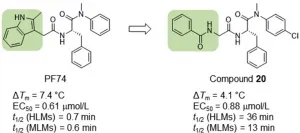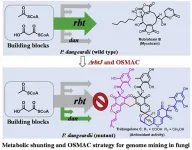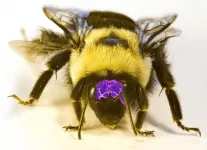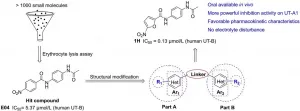(Press-News.org) Researchers at GMI - Gregor Mendel Institute of Molecular Plant Biology of the Austrian Academy of Sciences - uncover an ingenious mechanism by which Arabidopsis safeguards the integrity of its genome. The paper is published in the journal Nature Cell Biology.
Is it possible for one single gene product to silence undesirable genetic elements? Can such a strong effect be seen in the regulation of Transposable Elements (TEs), or genome parasites? If yes, how does this gene product singlehandedly keep transposons in check? New research from Frédéric Berger's group at GMI provides answers to these questions and dissects a mechanism of gene silencing that has long remained shrouded in mystery.
Genome parasites
Although jumping transposons promote genomic variation at an evolutionary scale, their effects on an individual organism are massively deleterious. If left unregulated, they could give rise to genome instability and various diseases. In the model plant Arabidopsis, loss of function of one single gene product identified 30 years ago, Decreased DNA Methylation I (DDM1), was shown to result in vast and uncontrollable transposition events. DDM1 is a chromatin remodeler that helps keep DNA tightly packed to silence TEs, but the underlying mechanism how DDM1 silences TE was still unknown.
Trapped before they jump!
The team around GMI group leader Frédéric Berger, with co-first authors Akihisa Osakabe and Bhagyshree Jamge, describe the molecular mechanism of action of DDM1. They show that DDM1 targets TEs by binding H2A.W, a variant of the histone H2A, one of the building blocks that coat DNA to form the condensed and tightly packed heterochromatin. The team demonstrates that the deposition of H2A.W by DDM1 on DNA regions rich with TEs is not only necessary, but also sufficient to remodel the chromatin and silence the TEs. Importantly, the team shows that this mechanism dominates by far other known TE silencing mechanisms in Arabidopsis and that the effect of DDM1 is specific for jumping genes with intact transposing potential, i.e., potentially mobile TEs. "Transposons integrate the genome and thus share chromatin with the host. They can be viewed as enemies hiding in houses. What makes these houses distinct from those hosting protein coding genes? - The material used to build these houses is different: it enshrines transposons such that they can't go out and multiply," says Frédéric Berger. The silencing mechanism described does not affect fragments of jumping genes that have lost their ability to transpose independently, neither does it affect protein coding genes. Frédéric Berger does not hesitate to describe the mechanism with some humor: "Basically, the strategy is: enshrine your enemy in building blocks made of special material and send him to hell!".
Sent to hell packaged by DHL
The association with hell comes from "Hells", the name of the human ortholog of Arabidopsis DDM1. The researchers propose a new class of chromatin remodelers, grouping DDM1 and Hells together with their mouse ortholog Lsh, that they term "DHL". The DHL chromatin remodelers show conserved binding sites for the histone variants. In addition, all three remodelers have been associated with genomic instability and disease in their respective organisms, in case mutations lead to their loss of function.
DHL remodelers control transposons dynamics
DDM1 is the key factor in "camouflaging" TEs away from the transcriptional machinery by utilizing special "building blocks" that prevent their recognition. Asked about the broader impact of this novel mechanism, Frédéric Berger states: "DDM1 orthologs in mammals deposit the H2A.W ortholog variant macroH2A, which has been implicated in various human syndromes and cancers. Better insight into the mechanism of action of this class of histone binding proteins will advance our understanding of genome dynamics with impacts on medicine and evolution".
Engineering silencing mechanisms in yeast
Frédéric Berger, who has received funding from the "1000 Ideen" grant for high-risk research from the Austrian Science Fund (FWF), is already investigating emergent properties of these histone variants and chromatin remodelers and engineering novel silencing pathways in yeast based on the Arabidopsis H2A.W and DDM1.
INFORMATION:
Original publication:
Osakabe, Jamge et al., "The chromatin remodeler DDM1 prevents transposon mobility through deposition of histone variant H2A.W", Nature Cell Biology, 2021. DOI: https://dx.doi.org/10.1038/s41556-021-00658-1
Flamingo chicks raised by foster parents from another flamingo species develop normally, scientists say.
Six Chilean flamingo chicks were reared by Andean flamingos - a species of similar size and behaviour - at WWT Slimbridge Wetland Centre in the summer of 2018.
University of Exeter scientists studied the chicks' behaviour after they re-joined the Chilean flamingo flock early in 2019.
The results showed fostering had no negative effects, with fostered flamingos still forming stable social ties - making "friends" and behaving like parent-reared birds.
"Slimbridge's Andean flamingos hadn't nested for about 20 years," said Dr Paul Rose, of the University of Exeter.
"But in the ...
Novel PF74-like small molecules targeting the HIV-1 capsid protein: Balance of potency and metabolic stability
https://doi.org/10.1016/j.apsb.2020.07.016
Of all known small molecules targeting human immunodeficiency virus (HIV) capsid protein (CA), PF74 represents by far the best characterized chemotype, due to its ability to confer antiviral phenotypes in both early and late phases of viral replication. However, the prohibitively low metabolic stability renders PF74 a poor antiviral lead. The authors report on their medicinal chemistry efforts ...
A consortium of researchers from Russia, Belarus, Japan, Germany and France led by a Skoltech scientist have uncovered the way in which Mycobacterium tuberculosis survives in iron-deficient conditions by utilizing rubredoxin B, a protein from a rubredoxin family that play an important role in adaptation to changing environmental conditions. The new study is part of an effort to study the role of M. tuberculosis enzymes in developing resistance to the human immune system and medication. The paper was published in the journal Bioorganic Chemistry.
According to the World Health Organization, every year 10 million people fall ill with tuberculosis and about 1.5 million die from it, making it the world's top infectious killer. ...
A great need for better pain treatment
After an appendectomy, a quarter (24.8%) of all children wanted a stronger pain treatment in the first 24 hours after their operation. Among children who had a tonsillectomy, this was one-fifth (20.2%). Analysis of the data showed that this desire was primarily associated with sleep impairments and with movement pain. The lead author of the study, Prof. Ulrike M. Stamer, explained: "We are dealing with a large number of affected patients. Appendectomies and tonsillectomies are the most common operations performed on children overall. Just under a quarter of these cases strongly signal a desire for
improvement".
A comprehensive, multicentre study
This study is based on the international pain registry "PAIN OUT infant", which was established ...
TAMPA, Fla. (April 8, 2021) -- A dysfunctional immune system significantly contributes to the development of cancer. Several therapeutic strategies to activate the immune system to target cancer cells have been approved to treat different types of cancer, including melanoma. However, some patients do not show beneficial clinical responses to these novel and very promising immunotherapies. In a new article published in Proceedings of the National Academy of Sciences of the United States of America, Moffitt Cancer Center researchers demonstrate how an important defect in STING gene expression in melanoma cells contributes to their evasion from immune cell detection and destruction.
Several different mechanisms have been discovered ...
Genome mining combined metabolic shunting and OSMAC strategy of an endophytic fungus leads to the production of diverse natural products
Endophytic fungi are promising producers of bioactive small molecules. Bioinformatic analysis of the genome of an endophytic fungus Penicillium dangeardii revealed 43 biosynthetic gene clusters, exhibited its strong ability to produce numbers of secondary metabolites. However, this strain mainly produce rubratoxins alone with high yield in varied culture conditions, suggested most gene clusters are silent. Efforts for mining the cryptic gene clusters in P. dangeardii, including epigenetic regulation and one-strain-many-compounds (OSMAC) approach were failed probably due to the high yield of rubratoxins. A metabolic ...
A team of archaeologists in north-west the Kingdom of Saudi Arabia has uncovered the earliest evidence of dog domestication by the region's ancient inhabitants.
The discovery came from one of the projects in the large-scale archaeological surveys and excavations of the region commissioned by the Royal Commission for AlUla (RCU).
The researchers found the dog's bones in a burial site that is one of the earliest monumental tombs identified in the Arabian Peninsula, roughly contemporary with such tombs already dated further north in the Levant.
Evidence ...
Indole, and structures derived from it, are a component of many natural substances, such as the amino acid tryptophan. A new catalytic reaction produces cyclopenta[b]indoles--frameworks made of three rings that are joined at the edges--very selectively and with the desired spatial structure. As a research team reports in the journal Angewandte Chemie, the rates of the different steps of the reaction play a critical role.
Indole derivates are widely distributed in nature; they are part of serotonin and melatonin, as well as many alkaloids--some of which are used as drugs, for example, as treatments for Parkinson's disease. Indole is an aromatic six-membered ring fused to a five-membered ring along one edge. The five-membered ring has a double bond and ...
Using a surprisingly simple technique, researchers in the University of Arizona Department of Neuroscience have succeeded in approximating how many brain cells make up the brains of several species of bees, ants and wasps. The work revealed that certain species of bees have a higher density of brain cells than even some species of birds, whereas ants turned out to have fewer brain cells than originally expected.
Published in the scientific journal Proceedings of the Royal Society B, the study marks the first time the new cell counting method has been applied to invertebrate animals and provides a robust and reproducible protocol for other research groups studying the brains of ...
Discovery of novel diarylamides as orally active diuretics targeting urea transporters
Urea transporters (UT) play a vital role in the mechanism of urine concentration and are recognized as novel targets for the development of salt-sparing diuretics. Thus, UT inhibitors are promising for development as novel diuretics. In this study the authors discovered a novel UT inhibitor with a diarylamide scaffold by high-throughput screening. Optimization of the inhibitor led to the identification of a promising preclinical candidate, N-[4-(acetylamino)phenyl]-5-nitrofuran-2-carboxamide ...





